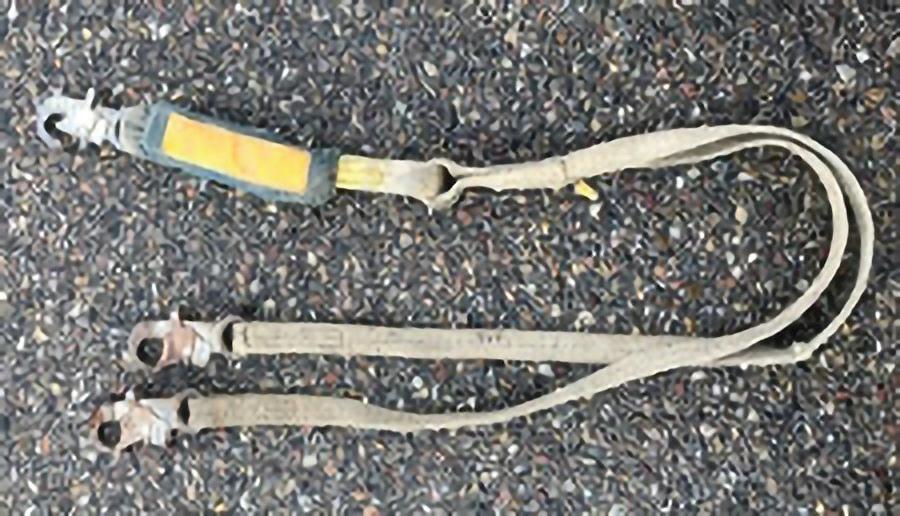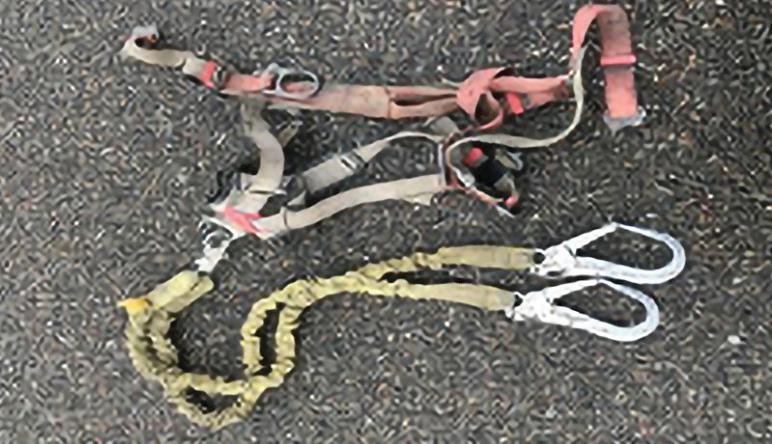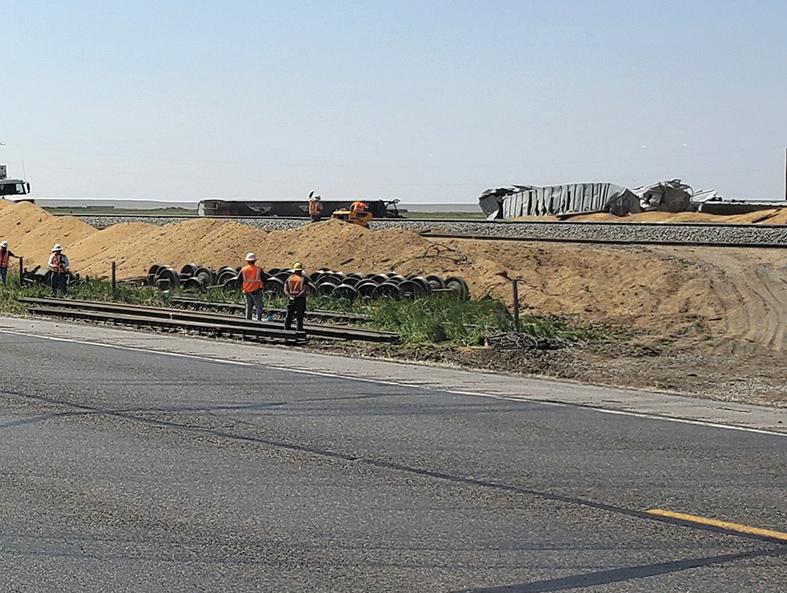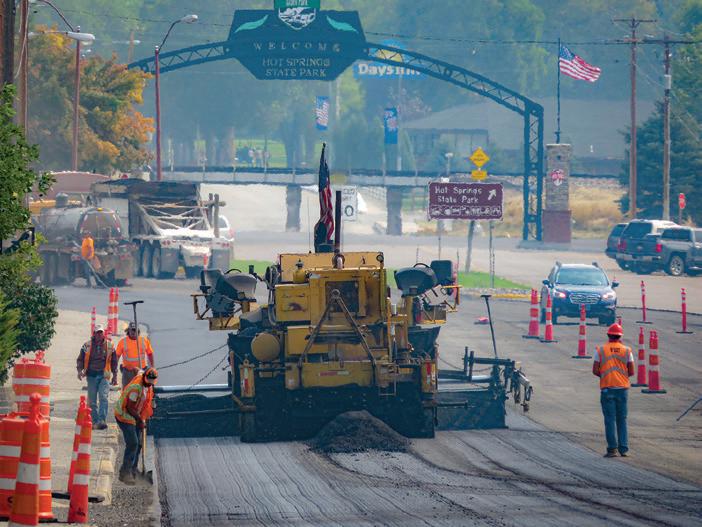
7 minute read
Employee Safety
by WYDOT
The Importance of a Safety Culture By Geoff McPherson, Employee Safety
Anchorage points associated with fall protection equipment were placed on the sides of a United States Naval dry dock. This was so employees of a concrete company could attach fall protection equipment and perform spall repairs at heights while being protected from falls. An experienced employee was saw-cutting the concrete and safely tied off. He had an assistant that had six months on the job. The saw needed fuel; he climbed down, unhooked the fall protection equipment and then went to refuel the saw.
When he returned he did not re-tie to the fall protection equipment, instead he climbed up and began saw-cutting. When he finished saw-cutting he lowered the saw below to his assistant. During his descent he slipped and fell. The total distance of the fall was 15-feet. He broke his shoulder, collar bone, tailbone and every rib in his body. He also bruised his right kidney. The assistant did not feel comfortable informing the senior co-worker that he needed to be tied off. If the company had a good safety culture the assistant would have spoken up. What does a good safety culture mean? Does it mean a positive safety record or does it mean plans have been made for safety? The simplest answer is a safety culture is attained when employees have inclusion in the successful completion of all tasks. In other words, employees feel they have a say in discussing the hazards associated with their job assignment tasks and the methods to remove the hazards.
Some common barriers to achieving a good safety culture in an organization are:
1. Productivity before safety
Productivity always comes before safety, as safety is viewed as a cost, not an investment.
2. Fear
Problems remain hidden as they are driven underground by those trying to avoid sanctions or reprimands.
3. Ineffective leadership
Blinkered leadership and the prevailing corporate culture prevent the recognition of risks and opportunities leading to wrong safety decisions being made at the wrong time, for the wrong reasons.
4. Non-compliance
Managers and the workforce not following the standards, rules and procedures.
5. Miscommunication
Critical safety information is not relayed to decision-makers and the message has been diluted.
6. Competency failures
There are false beliefs that direct hires and contractors are highly trained and competent.
7. Ignoring lessons learned
Critical safety information is not extracted, shared or enforced.
The Employee Safety Team continues to coordinate efforts with all levels of leadership to develop procedures and methods to encourage a good safety culture. A case in point is the new Job Safety Analysis (JSA) policy and how supervisors are advised to work closely with their subordinates in the creation of localized JSAs. In addition to JSAs, Toolbox Safety Briefs are also an ideal way to get the feedback from the employees and to build trust.
Over the past year, the Employee Safety Team has also worked with managers and employees to improve the delivery of the clothing allowance and prescription eye wear program. These efforts led to employees receiving stipends to purchase work clothing that increases their comfort and safety while at work. Also, employees requiring prescription safety eye wear can now receive prescription quality safety eye wear at no personal cost. These changes were prompted by feedback from employees statewide and we will continue to evaluate other safety initiatives to improve our culture.
We often hear that some people think that a good safety culture cannot exist due to our high-operation tempos. This line of thinking is wrong. Much larger companies than ours have been tremendously successful in creating a positive and preventative safety culture within its organization.
One example is Northrop Grumman, a company that employs more than 90,000 personnel, where a strong safety culture exists and has been a central focus for generations. Their safety program states, “We work to protect the health and well-being of our employees and to provide our customers with high-quality, reliable and safe products. We are committed to safe operations and are diligent in our safety practices and processes. Every employee has a voice in ensuring that they and their coworkers are not exposed to hazards in the workplace. This benchmark safety culture has significantly improved morale, leading to greater production with far less accidents, and resulting in better economic results.” We should aspire to achieve a safety culture like Northrop Grumman and other highly successful companies. Over the past six months, WYDOT has had two employees who have suffered major injuries from falls similar to the one discussed at the beginning of this article. These valuable members of our team are now experiencing personal suffering and dealing with the discomfort of their injuries. Let us make a commitment to each other to not fall into any of the traps of putting productivity before safety, to use miscommunication, or a lack of training as an excuse to focus only on getting the job done. An organization with a good safety culture is characterized by communications founded on mutual trust, by a shared perception of the importance of safety, and by confidence in the efficiency of preventive measures. Changing our safety culture for the better starts with all employees working together to make a safer tomorrow. We’re committed to this challenge, are you?
“We must never forget that the highest appreciation is not to utter words, but to live by them.” – Former U.S. President John F. Kennedy
On the Horizon: Fall Protection By Jordan Striff, Employee Safety
What does fall protection matter? According to OSHA, falls are still among the most common causes of serious work related injuries and deaths. Most happen due to a lack of fall protection controls or equipment, lack of proper training or not completing a pre-job safety briefing, such as a Job Safety Analysis (JSA). WYDOT isn’t immune to falls and we have had two employee fall incidents with significant injuries in 2020. One of the biggest cause of injuries and accidents within the workplace is often just rushing to get the job done. You’re probably familiar with phrases, “I can get the job done faster without it,” “I don’t have 10 minutes to spare to don and doff the fall protection equipment,” or “It’s only 4 feet.” There are plenty of bad excuses on why someone may not wear fall protection, but there are a thousand reasons why you should. You matter! Your family, friends, co-workers and the citizens of Wyoming depend on you to safely meet WYDOT’s mission.
Earlier this year, I was tasked with building from the ground up WYDOT’s new Fall Protection Program and Policy. With the help of Todd DePorter (Employee Safety Program Manager) and Geoff McPherson (Senior OSHA Specialist), this program and accompanying policy are being painstakingly researched and developed. This new program is intended to make us safer at work and significantly improve our safety culture when it comes to fall protection. New standardized equipment: harnesses, trauma straps and self-retracting lanyards will be available through procurement. Additionally, specific training on the equipment, as well as on the known fall hazards will be offered. The program and associated training will also provide our supervisors clear direction and guidance to follow. This program brings everything together and will spell out when and where fall protection is required based on hazard recognition and analysis. The intended roll-out for the new program will be in January 2021.
There are different trigger heights and safety requirements for fall protection clearly outlined in OSHA and ANSI standards that WYDOT must comply with. Fall protection isn’t just a harness and lifeline (safety professionals call this a Personal Fall Arrest System or PFAS). It may also consist of guardrail systems, safety nets, positioning/restraint systems, ladders, aerial lifts, warning lines, controlled access zones and other safe work practices. By exercising this program, in combination with the JSA and safety discussion policies, it will give our supervisors and employees the training and knowledge to begin to think about fall hazards before the work ever begins. This will help to appropriately manage fall hazards and focus attention on prevention efforts, rather than the “after effects” of falls (rescue, injuries or fatalities). This program is an example of the safety bedrock the WYDOT Employee Safety Program is striving instill. It is intended to transition us into a leading indicator program, which predicts and eliminates hazards before they occur, and in turn creates a stronger safety culture for you.
Best practice dictates that fall protection be an integral part of our safety program and by promoting this change in safety culture, we hope to accomplish the most meaningful goal for any safety program: protecting the safety and health of our employees. We want you to be safe on the job, so you can enjoy time off the job. You are an important member of our WYDOT family and it is why fall protection matters. n
Photo: WYDOT Old and worn equipment removed from a WYDOT program. This equipment was replaced with new fall protection harnesses and lifelines.






